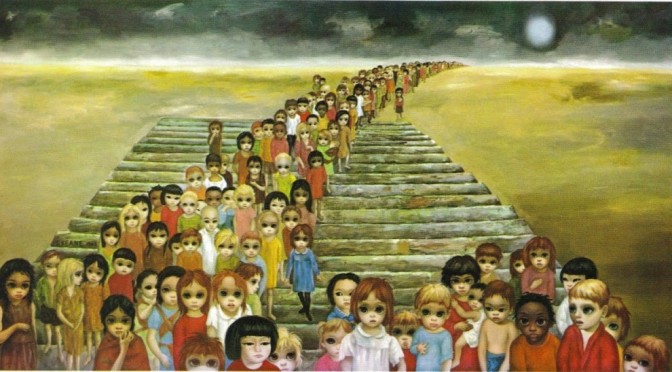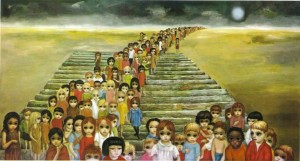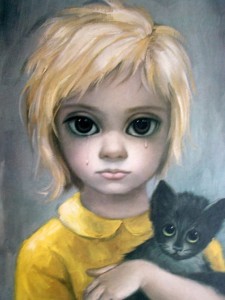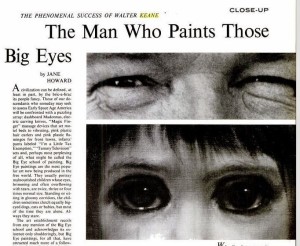The World’s Fair of 1964-65 at Flushing Meadows-Corona Park was a major American event forward-looking in its intent and, in many ways, backwards in its practice. Â In particular, Robert Moses did not care for cheap carnival amusements, nor did he care for music or art that was particular edgy or controversial. Moses’ tastes ruled supreme over the Fair as he held veto power over any works that were in “extreme bad taste or low standard.”
There was no pavilion dedicated to art although several independent partners funded their own art displays. Â The New York State Pavilion presented the work of brand-new pop artists; an objectionable piece by Andy Warhol entitled Thirteen Wanted Men was eventually painted over (although it was the governor Nelson Rockefeller who objected in this case).
Moses did eventually throw out one surprising piece of artwork — Tomorrow Forever by Margaret Keane.
The Keane painting was to have been displayed in this building at the fair.**
Keane was known for her bizarre and haunting images of children and animals with large empty eyes. Â During the 1960s, her husband Walter Keane claimed to be the creator of her paintings. Â It was he who was announced as the painter of this macabre work, chosen in February 1964 to grace the Fair’s Hall of Education. Â The venue devoted to the future of schools would feature a scale model of an elementary school from the year 2000, a playground with “futuristic climbing structures,” and from the entrance way, the terrifying painting you see above.
The work by Keane, representing “something which would be symbolic for the aspiration of children,” was not exactly heralded as the pinnacle of artistic expression in 1964.
The New York Times’ art critic John Canaday could barely conceal his disgust at this “grotesque announcement,” adding, “Mr. Keane is the painter who enjoys international celeÂbration for grinding out formÂula pictures of wideâ€eyed children of such appalling sentimentality that his product has become synonymous among critics with the very definition of tasteless hack work.”  [source]
To be fair, Canaday had only seen a photograph of the painting, which depicts an endless sea of soul-crushing zombie children, rising out of a morose and barren wasteland. “That’s true,” he confessed to a Life Magazine reporter. “It’s normally a principle of mine never to judge just by a photograph, but in this case it didn’t matter.”
Moses seemed to agree with Canaday, demanding the Hall of Education cancel the planned installation before it was even mounted. Â Thanks to Canaday’s protest, Moses’ office was inundated with letters from angry intellectuals and aesthetes. “[T]he perpetrators of this art burlesque,” wrote Joseph James Akston, “expose us to veritable scandal sure to incur ridicule and laughter of the whole civilized world with possible exception of Russians.” [source]
Keane, who of course didn’t paint the artwork attributed to him, nonetheless seemed to revel in the critical potshots. Â The following year, he issued a press releases from San Francisco and Tahiti, declaring himself “the American Gauguin.” Â Canaday would continue to take aim at Keane’s kitschy work. Â Imagine how Canaday felt when he discovered that Walter hadn’t even painted the works he so deliciously despised?
Margaret eventually left her husband and sued for rightful ownership of her artwork.
Below: From a Life Magazine profile in August 1965:
NOTE: I’m being a little irreverent in calling the painting “terrifying” as the artist clearly intended the subjects to be starving, sad children. Â However, the passage of time has been a little strange to Keane’s legacy. Â She is perhaps more beloved than ever — there’s a new Tim Burton film coming out this year — but the flagrant sentimentality of the work has given way to their spectacular kitsch value.
** The Hall of Education picture courtesy the blog Little Owl Ski which has a few other nifty World’s Fair pictures.






27 replies on “Robert Moses rejected this terrifying Margaret Keane painting from hanging at the 1964-65 World’s Fair”
Thanks for this story. After seeing the intriguing film “Big Eyes” I was curious to the backstory of Keane’s “Tomorrow Forever” since the film only gave the artwork a few minutes. Real life is often stranger than the most creative and imaginative fiction.
“Tomorrow Forever†is a painting that portrays childhood as a march to the apocalypse: perhaps prophetic . .. perhaps, happy times . ..
When I look at this painting, I see hope, not terror. I see vulnerability in their eyes but not desperation. I imagine that their large eyes, signify the mass amounts of wisdom that these children have within them. They are wiser than you or I BECAUSE they are vulnerable and have seen more of the worlds sorrow than any of the eyes looking AT them. The eyes are the window to the soul indeed, and the soul, is where our wisdom resides.
Yeah yeah, think whatever you want about the paint makes you feel, its still awfull, don´t get me wrong a love the artist, but she was forced to do them, you sound like her ex trying to sell it. It is just a reflection of herself being abused, it never intended to help children or inspire, she was suffering for herself. And painting poor sad children its a horrible and stupid way to represent childhood, it is yellow, its offensive, just like puting starving african people in billboards to make people feel… dunno better with blund lifes, (because they dont donate or help anyway).
The paiting tried to force people to feel pity or shame about a world know subject, it was intended to sell really high using people feelings and simpathy, and they did, they fell like flies on the honey, like saying “oh poor kids, im gonna buy it so i dont feel so bad about them”
Its just wrong…
The feeling you are getting from this is just what you want to feel
That is true.
I had just watched the movie last Friday and it opened my eyes to it.
I have painted one of my very own.
I think it’s for a good reason.
Those mean people are pig headed.
You must be from the 60s….not necessarily stoned but then again,yes.
I,love the art work of this artist, and enjoyed the movie Big Eyes. We live in a world where a female always has to fight,and work extremely hard to become accomplished.
Mrs.Margaret thank you for sharing with the world your struggle to success. I, found the Tomorrow/ Forever painting ten years ago in
a thrift shop. What caught my attention was
the diffrent nationalities of children. At that time I was a daycare teacher who valued seeing children in their normal surroundings.
RITA
re you convened the one you found in a thrift store to be the Original painted by Keanne, It has to be Irreplicable in its value today.
Where is it Today ?
Why would anyone want to take such a masterpiece down?
People who don’t appreciate what they have today.
They have everything they wanted in life and they don’t want to know about what happened In the story and the world right now!
Why call this painting terrifying? It’s not at all terrifying, but it looks rushed and badly conceived, with a terrible color scheme. According to the movie Big Eyes, that was part of the problem with it. It does not look like it took very much time to paint even though it contains too many kids to be a good composition. It’s a bad painting but not terrifying.
Does anyone know what happened to the original painting? Where is it today?
I have the original painting in original costom frame and I’m interested in selling it for my daughter’s college fees. Anybody interested please email me at powersurge81868@gmail.com
Thank you.
I am interested in the original painting of Tomorrow Forever painting. Let me know how much.
Thanks
Mike
Eu tb gostaria de saber onde está a tela Tomorrow Forever atualmente , agradeço a atenção .
I love her Art every single masterpiece!
“Big Eyes” is a biopic that tints its characters and events with dramatic license. If the movie’s “Tomorrow Forever” segment depicts the truth, Margaret Keane was forced, under duress from her husband, to create a sweeping, epic mural for the World’s Fair. This was assembly-line production, not art. Mrs. Keane seems to have borrowed the landscape from Gaugin, both in composition and color. The children aren’t big-eyed; they’re empty-eyed, perhaps reflecting Mrs. Keane’s own circumstances.
By the way, the best scene in “Big Eyes” was when Walter feigned shoulder pain in the middle of a court battle. Priceless, and 100% true!
Art is about passion and development, something Walter wouldn’t allow. So when this, the pinnacle of forced art was released, it’s no shock it wasn’t loved. It was just a painting, no soul or heart in it. So simply, it wasn’t art.
Thanks for the acknowledgement of the picture from my blog! I’m just getting back into the swing of things at Little Owl Ski so I’ve only just seen your piece. Really interesting. I’ve still not seen the film, but despite my love for all things retro I’ve never been a fan of the Keane pictures. Emma
I have never seen her work before that I know of. Long ago, the definition of a good artist was to “faithfully” reproduce what was seen, the more realistic the better. Then came cameras and suddenly no artist could reproduce better. This brought about a new age in art, where subtle nuance and interpretation became more important. New art was now defined by how the viewer interpreted it (of course many of the masters did this previously). With this I believe art of the 19th, 20th, and 21st century should now be determined by its “soul” and the more interprets its has from people that actually study it, the higher the art as it will be alive and its meaning will change based on their experiences, current events, and culture. Reading the different interpretations, I think that alone provides proof of the value of this work. As to my interpretation of this painting, I see no horror or despair. I see children, most confused, almost all curious, and a few suspicious and wary. They know they are moving into the future and know not what it will bring but know they must go to it.
I was acquainted with the Keane’s at the height of their fame in 1963 when their daughter was a high school friend and invited us many times to their home in Woodside. The secret was still not out, and their studio had two easels side by side, with half-finished paintings, one in “his” style and the other in “hers.” Being 18 and knowing all about art, I announced that “she” was the better artist, never imagining the truth. “Big Eyes” did not capture her elusive, sad, fragile quality. She was into magical thinking and read our palms one evening. All of us liked her, a “flower child” before her time. Walter, on the other hand, was smarmy, abrupt and abrasive, and one night we overheard a terrible family fight. For years I kept a lithograph of “On the Threshold,” a Margaret Keane work she had given me herself. Somehow, those paintings captured the imagination, however tasteless they may have been. There had been nothing before quite like the Keane fad in the early 1960’s. I was working as a newspaper boy in those years, and when it came time to collect, I noticed Keane prints in almost every vestibule in our Bay Area neighborhood. One day prior to my even meeting the Keane’s, my father had brought home two coffee table books featuring The Keane’s. He was a newspaper man and brought them home almost as a joke, but I was fascinated by the whole weird thing. They would probably be collectors’ items now. I lost “On the Threshold” during one of too many moves, but I doubt I would hang it anywhere these days except as an oddity from the past.
I sense jealousy with all these masterpieces. They are beautiful it represents abandonment of so many children and poverty back in those days…..why not criticizing the millions of nudity exposed in museums where children see them…..I think she is brilliant and and had a vision of children back in those days….if you cannot say something positive why negative it only affects you not her…..she is successful with her painting……just saying
I love those paintings I have a big one my husband gave to me 1960
Beautiful,I have one from1960
Anime and manga characters have HUUUUUGE eyes and no one bats a…well…an eye. Women’s makeup accentuates their eyes (the smoky look) to make them look bigger. Belladonna was used hundreds of years ago to make women’s eyes (pupils actually) look bigger. So whatever. This stuff is kitsch but it still has appeal. My wife and I have a large 1963 print of this work framed in our living room and it works. We have foster kids as well. Haters gonna hate.
Hilarious article, I love your sardonic comments. I just watched the movie and was interested in this painting. I was a kid in the 1960s and remember seeing Keane reproductions in various places. They impressed me as bizarre rather than endearing. I’m glad an art scandal was connected to them.
What would that painting be worth?